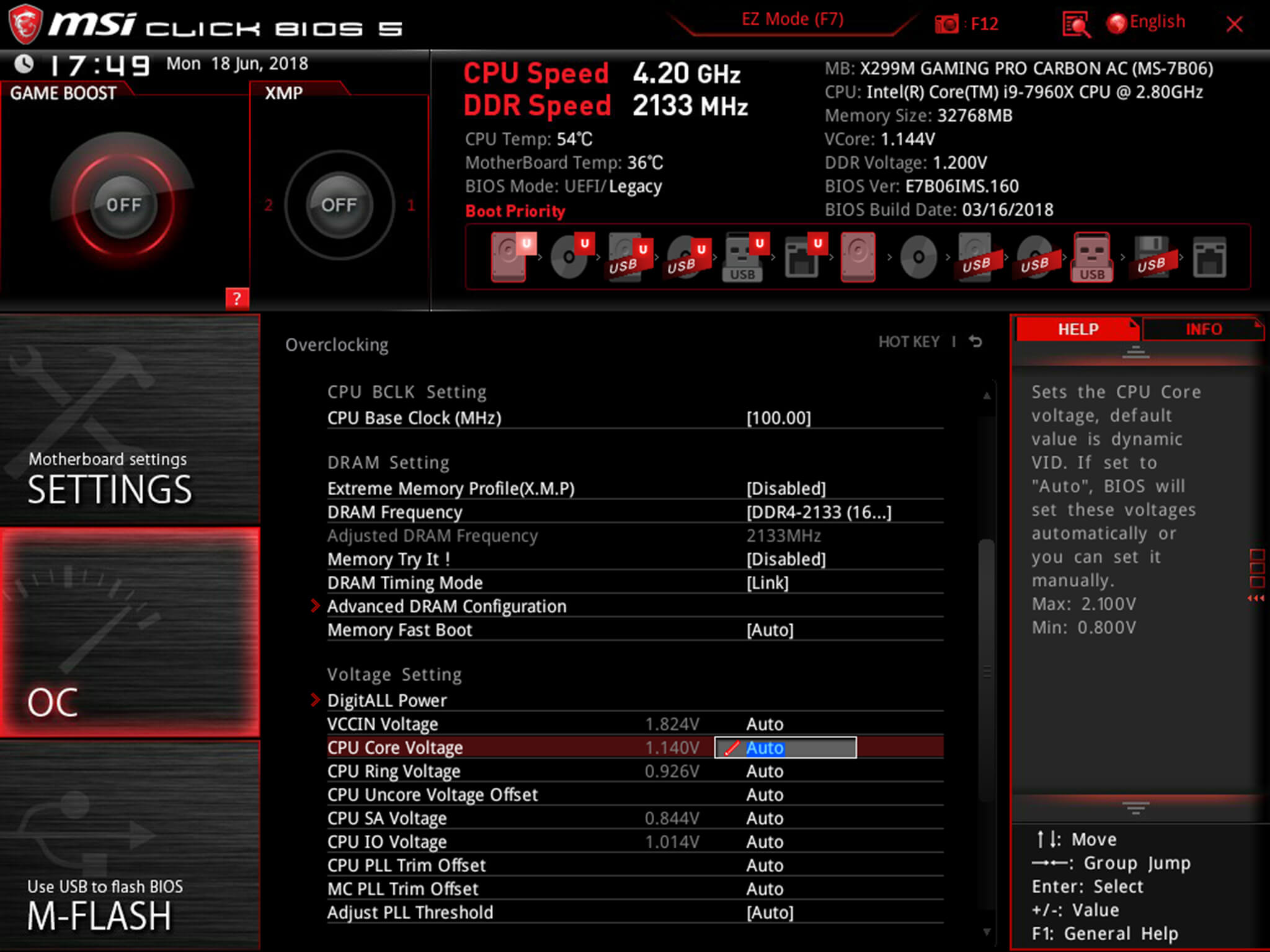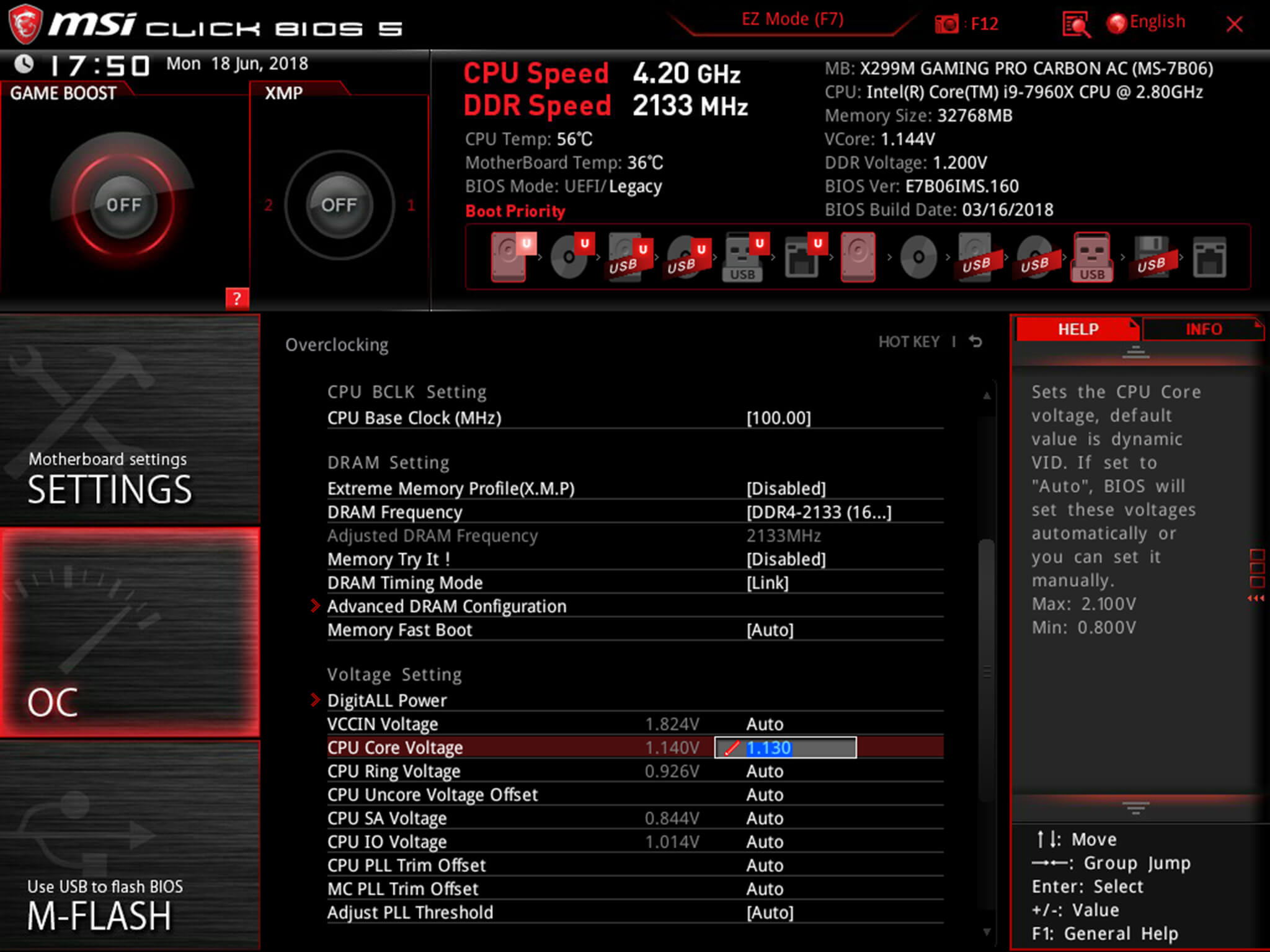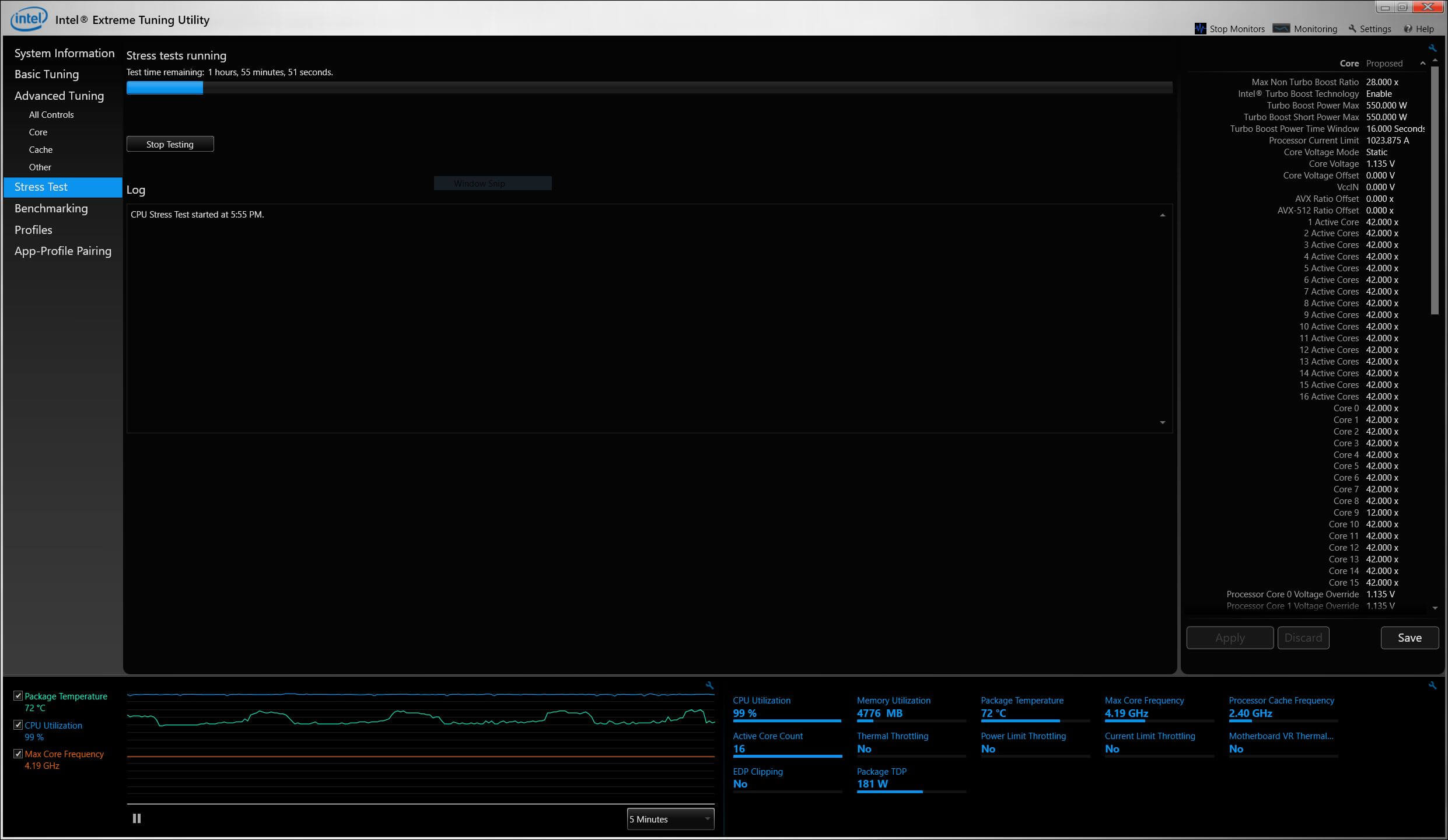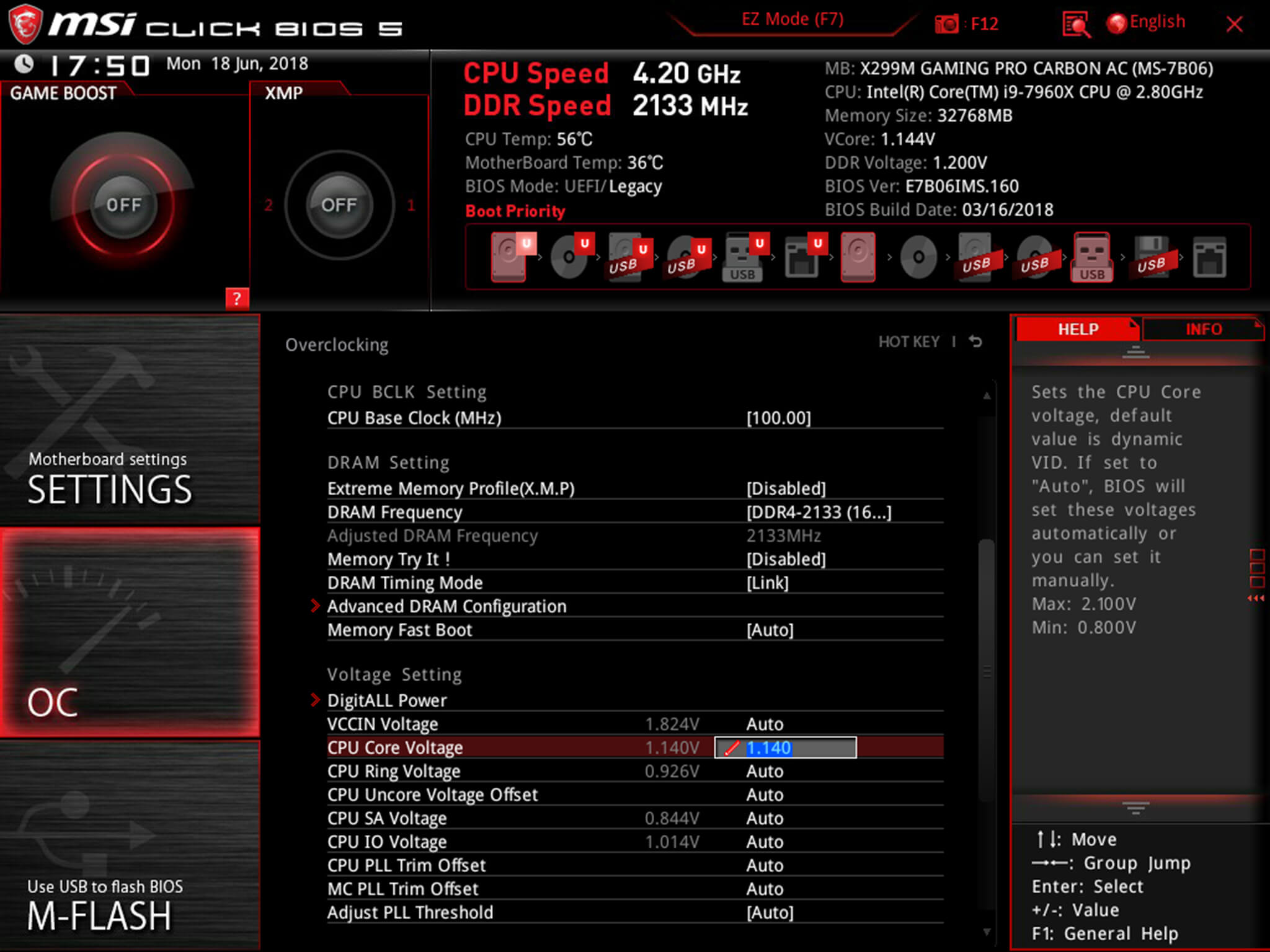The core voltage is different for each processor model, and while all CPUs of the same model have the same VID, not all samples maintain stability at the same clock speeds and Vcore due to slight variations in silicon quality. Every sample of the same CPU model is tested to maintain stability at the default speeds and the VID determined by the manufacturer.
Core voltage typically maintains a constant value while your CPU is in use; however, sometimes under heavy workloads vcore can fluctuate. This is known as Vdroop and can be corrected with load-line calibration. This applies additional voltage as load increases to maintain your CPU's stability.
When it comes to overclocking, you can only push your CPU's frequency so far before your CPU starts to experience instability. Programs might begin to crash or hang up, game performance could suffer or your computer could even fail to boot. This is because your processor isn't getting enough voltage to maintain system stability.
Increasing voltage will allow you to dial in the perfect overclock.
To adjust the voltage, you'll need to boot into your motherboard's BIOS and make adjustments there. The Vcore is expressed as a three decimal value, such as 1.235v. By default, the voltage control is set to auto; this can be overridden by typing in any value. Make sure not to exceed the recommended maximum for your processor.

Before fine-tuning the Vcore, it's important to find a good baseline value for a given speed. This varies from model to model but it can be helpful to read reviews for your CPU, specifically ones that focus on overclocking.
Most publications will list the voltage they required to keep several different speeds stable. Every CPU sample is different and you will need to fine-tune the voltage before calling it done; however, these values do provide a good starting point.

If you boot your machine and don't find any stability issues, then you know it's time to start decreasing the voltage. When overclocking, you want to find the lowest voltage required to maintain stability. More voltage equals more heat and this will allow you to keep temperatures under control.

The safest way to adjust voltage is with increments of .01 volts. Decrease voltage until your computer starts showing signs of instability under load. Use a program like Intel's Extreme Tuning Utility (XTU) or Prime95 to stress test your processor.
If the test fails or crashes, then you need to raise the voltage back up to the previous stable point. For optimal efficiency, you can increase the voltage by .005 instead and again test for stability.

Conversely, if your overclock isn't stable at your baseline voltage, you will then need to increase the voltage until your computer shows no adverse effects and then decrease in increments of .005 to fine tune.

Overclocking is not the only time it can be useful to adjust voltage. As mentioned, higher voltage levels cause your CPU to generate more heat, regardless of frequency. Some CPU samples may have a higher VID than is actually required at the default frequency. Undervolting your processor allows your to maintain stability while decreasing temperatures and extending the life of your processor.
It's a common misconception that disabling Turbo Boost is a more effective substitute for shedding heat. While this does result in decreased temperatures, it is not an alternative as the purpose of undervolting is to maintain the same level of performance while generating less heat. When making adjustments, the same principles apply here as with overclocking, decrease Vcore in increments of .01 and then fine tune with adjustments of .005.
 Meta continues its submission to Trump with new advisor on its board
Meta continues its submission to Trump with new advisor on its board
 Varys just proved he's the most trustworthy character in Westeros
Varys just proved he's the most trustworthy character in Westeros
 4 ways entrepreneurs can save money without giving up Starbucks
4 ways entrepreneurs can save money without giving up Starbucks
 NES Classic returned, briefly, but 'thousands' sold out in short order
NES Classic returned, briefly, but 'thousands' sold out in short order
 NYT mini crossword answers for May 9, 2025
NYT mini crossword answers for May 9, 2025
 NES Classic returned, briefly, but 'thousands' sold out in short order
NES Classic returned, briefly, but 'thousands' sold out in short order
 Amazon has its eye on the car market in next step toward world domination
Amazon has its eye on the car market in next step toward world domination
 Nokia's flagship smartphone to be announced on Aug. 16
Nokia's flagship smartphone to be announced on Aug. 16
 Tennessee vs. UCLA 2025 livestream: How to watch March Madness for free
Tennessee vs. UCLA 2025 livestream: How to watch March Madness for free
 Google just announced a new safety feature to keep you safe and informed during a crisis
Google just announced a new safety feature to keep you safe and informed during a crisis
 Shop the Shark FlexStyle for 20% off at Amazon
Shop the Shark FlexStyle for 20% off at Amazon
 Silicon Valley entrepreneurs launch online tool to help women fight sexual harassment
Silicon Valley entrepreneurs launch online tool to help women fight sexual harassment
 'Splatoon 2' is already a treasure trove of dank meme art
'Splatoon 2' is already a treasure trove of dank meme art
 It's Superheroes vs. smartphones at Comic
It's Superheroes vs. smartphones at Comic
 Girl Scouts adds 23 STEM badges in biggest rollout in nearly a decade
Girl Scouts adds 23 STEM badges in biggest rollout in nearly a decade
 George R.R. Martin is working with Neil deGrasse Tyson on a video game
George R.R. Martin is working with Neil deGrasse Tyson on a video game
 Nokia 8 leak reveals strange, new smartphone color
Nokia 8 leak reveals strange, new smartphone color
 Best robot vacuum deal: Eufy Omni C20 robot vacuum and mop at record
Best robot vacuum deal: Eufy Omni C20 robot vacuum and mop at record
 Goodbye Flash and thanks for all the animated fish
Goodbye Flash and thanks for all the animated fish
Samsung is slated to receive massive revenue from the iPhone XTesla said it would build 1,500 Model 3s in Q3 2017, but it only built 260Here are the 10 Tom Petty songs you should listen to right nowFacebook to throw 1,000 more humans at its advertising problem'Destiny 2' players just slid into Xbox boss Phil Spencer's fireteam like it was NBDWalmart hones their sameMicrosoft's 'mixed reality' headsets aren't ready for primetimeGoogle algorithm fail puts 4chan's wrongly named Las Vegas gunman on top of searchHow Do Not Disturb While Driving works in iOS 11Tom Petty was a movie soundtrack staple. Here are 5 essential uses of his workInstagram's new stickers let you add polls to your StoryInstagram's new stickers let you add polls to your StoryTesla said it would build 1,500 Model 3s in Q3 2017, but it only built 260Here are all the signs and photos you need to see from Amber Rose's annual SlutWalkMarilyn Manson was hospitalized after stage prop collapsed on himSamsung is slated to receive massive revenue from the iPhone XFacebook says 10 million people saw Russia's 'divisive' political adsHuawei Mate 10 Pro is looking pretty in new leak'Rick and Morty' fans won: McDonald's will offer Szechuan sauceIn defense of the anticlimactic 'Rick and Morty' Season 3 finale Happy Birthday, C. S. Lewis by Sadie Stein William Styron in Letters, Part 3 by William Styron Trump called NYC a 'ghost town' but early voting lines say otherwise iOS 17 has updates to core features and a new Journal app Apple Vision Pro is incredibly expensive, but not for the reason you think Stephen King: The Musical, and Other News by Sadie Stein 'Quordle' today: See each 'Quordle' answer and hints for June 7 7 DIY Halloween candy delivery systems for socially distant trick Reading the Viaduct by Jessica Vivian Chiu William Styron in Letters, Part 4 by William Styron April Gornick, Untitled, 1996 by The Paris Review How many Apple products can you buy for one Vision Pro headset? We Have a ... Winner? (NSFW Anybody Can be Cool … But Awesome Takes Practice by Sadie Stein Peaks and Valleys: Leslie Stephen, Mountaineer by Alex Siskin Giants quarterback's spectacular fall is the funniest football moment of 2020 Beautiful Books, and Other News by Sadie Stein Biden trolls Trump on his COVID failures with a fake error page Win Lovely Gloves with a Brave New Turkey by Sadie Stein AI hype from Apple? Don't hold your breath
2.7874s , 10133.3671875 kb
Copyright © 2025 Powered by 【Corruption (1983)】,Evergreen Information Network